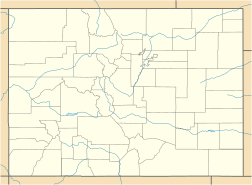Browns Park facts for kids
Quick facts for kids Browns Park |
|
|---|---|
| Highest point | |
| Geography | |
| Location | Moffat County, Colorado / Daggett County, Utah, Western United States |
Browns Park, also known as Brown's Park or originally Brown's Hole, is a quiet mountain valley in the Western United States. It stretches along the Green River in Moffat County, Colorado and Daggett County, Utah.
This valley starts in eastern Utah, about 40 kilometers (25 miles) downstream from Flaming Gorge Dam. It then follows the river into Colorado, ending at the Gates of Lodore within Dinosaur National Monument.
Browns Park was once a secret hiding spot for famous outlaws like Butch Cassidy and Tom Horn in the late 1800s and early 1900s. Today, it is home to the Browns Park National Wildlife Refuge, a protected area for animals. It was also the birthplace of Ann Bassett, who, along with her sister Josie Bassett, was known for being connected to some of Cassidy's gang members. The John Jarvie Historic Ranch is also located here, built by John Jarvie in 1880.
Contents
A Look Back: History of Browns Park
Early Days and Native Americans
When the first Europeans and Americans arrived in the early 1800s, the Browns Park area was home to several Native American tribes. These included the Comanche, Shoshoni, and Ute peoples. Other tribes like the Blackfoot, Sioux, Cheyenne, Arapaho, and Navajo also visited or used the valley.
Explorers like the 1776 Domínguez–Escalante expedition and the 1805 Lewis and Clark Expedition wrote about the Native American presence here.
Fur Trappers and Settlers
By the 1830s, Browns Park became a favorite spot for fur trappers and early settlers. In 1837, a trading post called Fort Davy Crockett was built. It helped with trade and offered protection from attacks. The fort was later abandoned in the 1840s, and fewer settlers lived there for a while.
A Hiding Place for Outlaws
After gold was found in California in 1848, the valley became a popular place for ranchers to keep their cattle during winter. By the 1860s, Browns Park gained a reputation as a hiding spot for outlaws. These included cattle rustlers (people who stole cattle) and horse thieves. It was known as a safe haven, similar to places like Hole-in-the-Wall, Wyoming, and Robbers Roost in Utah.
In those days, the people in Browns Park generally accepted most "outlaw deeds," but they did not tolerate murder.
Browns Park Today: A Wildlife Refuge
In 1965, much of the valley became part of the Browns Park National Wildlife Refuge. This refuge was created to protect waterfowl (birds that live near water) that migrate through the area.
The refuge still has parts of historic sites. These include the old "Two Bar Ranch" headquarters and the remains of Fort Davy Crockett. Lodore Hall, which is still used as a community center, and several old cabins from early settlers can also be found there.
Interesting Places in Browns Park
- Browns Park National Wildlife Refuge – A protected area for wildlife.
- Crouse Canyon – An old horse trail, now a dirt road.
- Gates of Lodore – A famous spot for accessing the river.
- Irish Canyon – Another historic trail with ancient rock carvings called petroglyphs.
- John Jarvie Homestead – A restored historic ranch.
- Old Ladore School, or Lodore Hall – A restored old school building and community hall, listed on the National Register of Historic Places.
- Swinging Bridge – A single-lane suspension bridge.
- Two-Bar ranch ruins – Old ranch buildings near Lodore Hall, also on the National Register of Historic Places.
- Vermillion Falls – A historic site along Vermillion Creek.



